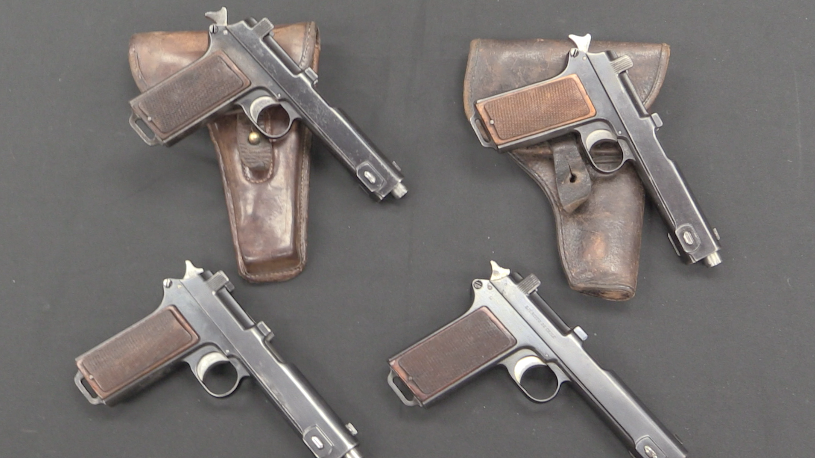The Carabinieros de Chile were formed in 1927 by combining the Rural Police, Fiscal Police, and Corps of Carabinieros into a single national police organization. We do not have an organization like this in the United States, but they are fairly common elsewhere in the world, acting as sort of a combination of National Guard, FBI, and police.
At any rate, the Carabinieros needed rifles, and in 1935 they placed an order for 10,000 carbines from Mauser in Oberndorf. These were chambered for 7x57mm Mauser (the standard Chilean military cartridge) and were all delivered prior to the outbreak of World War Two. They are excellent quality rifles, and feature a number of unique markings, most notable the receiver crest of crossed rifles over the Carbinieros motto, “Orden Y Patria”. They also have a unique sling arrangement, with the original Mauser quick-detach fitting fixed permanently in place by the addition of a saddle ring for mounted use.
This particular example is all matching, including the cleaning rod, and has very nice distinct stock markings.



I wonder how Chileans arranged priorities in gun purchases. This looks a bit expensive but probably worth every penny. And policemen were not guaranteed a long service life anyway.
Some queries from https://en.wikipedia.org/wiki/Timeline_of_Chilean_history as
(1927) In a bloodless coup, Carlos Ibáñez del Campo takes the presidency by force during great political instability. He subsequently governs as a dictator until 1931.
The corps of Carabineros — paramilitary police — is founded.
(1931) The deep economic crisis obliges Ibáñez del Campo to step down. A series of civilian governments and military juntas follows, some of which last no more than a few days.
(1938) Massacre of Seguro Obrero: the Carabineros execute members of the fascist National Socialist Movement of Chile (Nacistas), after the fascists attempted to oust the government in a coup d’état.
Cause me to think that Carabinieros might be considered by some as mean of gaining (or maintaining) power. However, I don’t have enough knowledge about Chilean internal policy in 1930s to decided if it was so or not.
Holding power, or at least defending the state against the wider population and any wannabe alternative masters, is the primary role of all state sector police and military
It usually says something different on the tin, but don’t be misled by that.
Historical experience and economic theory both point out the inefficiency and ineffectiveness of monopolies.
In the areas of policing and defence, economists and historians usually invoke some spurious idea that the market will somehow fail, and claims are made that these are somehow “special” areas of activity that must be provided coercively.
Non of those claims can stand up to scrutiny. The observations and analysis of Gustave de Molinari from 1847, are still valid.
What a sweet rifle.
Very sweet, the 7MM Mauser carbines are among my favorite rifles.
Good plan: buy the Mausers, keep them in service for multiple generations.
I have one. Well made, but not nearly as accurate as my 95 (or my 1902 roller). Every time I pick it up, I wonder what sort of injustices are in the baggage that accompanies this thing.
I had one of these about 20 years ago exactly like the rifle Ian reviewed. It was a very nice weapon and I’d shoot 1936 Kynoch spritzers through it. When my abilities lived up to the accuracy of the rifle it would get 1.5 inch groups at 100 yards. I’ve found that rifles from South America seem to invariably have either very good bores or very bad bores-mine had the former. Alas I sold it at a gun show to make space for self-loading rifles. Hopefully its still in the original condition and escaped “butcherizing”.
Sorry-that’s SPITZERS-not “spritzers”.